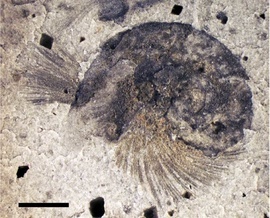Pelagiella exigua: A Stem Gastropod with chitinous chaetae from the Early Cambrian Kinzers Formation of Pennsylvania.
[sciencythoughts.blogspot.com]
Dextrally coiled Pelagiellids, globally distributed in Early to Mid-Cambrian assemblages of small shelly fossils, are among the best known of the early Conchiferans (one of two subphyla of the Molluscs, which includes the Monoplacophorans, Bivalves, Scaphopods, Cephalopods, and Gastropods). Their tiny shells (mostly 1–2 mm across, but Pelagiella atlantoides reached 9 mm) expand asymmetrically away from the plane of the first whorl, down the spiral axis, then back upward to establish an adult form that is almost planispiral, with a depressed apex. They have been treated implicitly or explicitly as stem group Conchiferans, as untorted Helcionelloids (an extinct branch of the Conchiferans known from the Cambrian and Early Ordovician), as Monoplacophorans, and explicitly as Gastropods presumed to have undergone torsion during their development (torsion, rotation of the visceral mass by 180° relative to the head and foot during larval development, is considered to be a key feature of Gastropods). Recently, together with the Aldanellids, they have been linked erroneously to the Hyolitha.


Enjoy being online again!
Welcome to the community of good people who base their values on evidence and appreciate civil discourse - the social network you will enjoy.Create your free account
Recent Visitors 21
BirdMan1
Florida, West Coast.,
EdEarl
San Antonio,
Lucy_Fehr
Fort Pierce,
Triphid
Broken Hill,
Surfpirate
Canada
Photos 292 More
Posted by JoeBKite-like structures in the western Sahara Desert.
Posted by TriphidAn Aussie Indigenous Message Stick.
Posted by TriphidIndigenous Australian Aboriginal Rock art dated somewhere between 20 and 30 thousand years old.
Posted by TriphidIndigenous Australian Aboriginal Rock art dated somewhere between 20 and 30 thousand years old.
Posted by TriphidIndigenous Australian Aboriginal Rock art dated somewhere between 20 and 30 thousand years old.
Posted by TriphidIndigenous Australian Aboriginal Rock art dated somewhere between 20 and 30 thousand years old.
Posted by JoeBDortoka vremiri: A new species of Dortokid Turtle from the Late Cretaceous of the Hațeg Basin, Romania.
Posted by JoeBThe Cabeço da Amoreira burial: An Early Modern Era West African buried in a Mesolithic shell midden in Portugal.
Posted by JoeBMusivavis amabilis: A new species of Enantiornithine Bird from the Early Cretaceous Jehol Biota of northeastern China.
Posted by JoeBTorosaurus in Canada.
Posted by JoeBStone tools from the Borselan Rock Shelter, in the Binalud Mountains of northeastern Iran.
Posted by JoeBDating the Lantian Biota.
Posted by JoeBBashanosaurus primitivus: A new species of Stegosaur from the Middle Jurassic of Chongqing Municipality, China.
Posted by JoeBDetermining the time of year when the Chicxulub Impactor fell.
Posted by JoeBSão Tomé and Príncipe: Possibly the last country on Earth never to have been visited by a working archaeologist.
Posted by JoeBMambawakale ruhuhu: A new species of Pseudosuchian Archosaur from the Middle Triassic Manda Beds of Tanzania.






